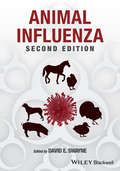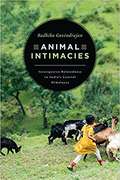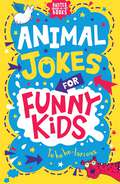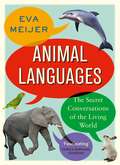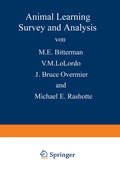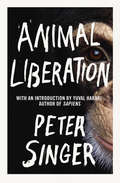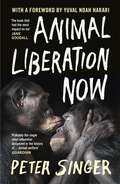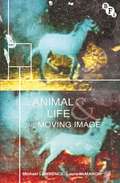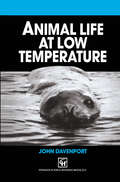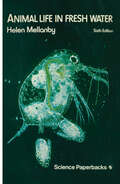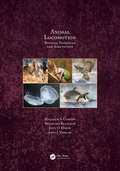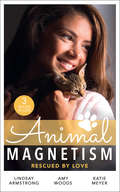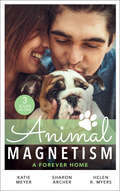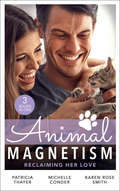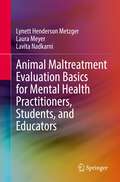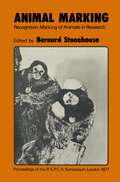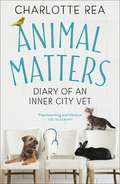- Table View
- List View
Animal Influenza
by David E. SwayneAnimal Influenza, Second Edition is a comprehensive text on animal influenza. Organized by species, coverage includes avian, swine, equine and mammals, with each section including data on influenza viruses, the infection and disease they cause, and strategies used in control. Covers the full range of topics within avian, swine, equine and mammalian influenzas in one comprehensive and authoritative text Provides a summarization of peer-reviewed and empirical data on influenza viruses, the infection, and diseases they cause Discusses strategies used in control of the disease Leading experts are drawn together to provide an international and multi-disciplinary perspective Fuses latest developments in basic scientific research with practical guidance on management of the disease
Animal Influenza
by David E. SwayneAnimal Influenza, Second Edition is a comprehensive text on animal influenza. Organized by species, coverage includes avian, swine, equine and mammals, with each section including data on influenza viruses, the infection and disease they cause, and strategies used in control. Covers the full range of topics within avian, swine, equine and mammalian influenzas in one comprehensive and authoritative text Provides a summarization of peer-reviewed and empirical data on influenza viruses, the infection, and diseases they cause Discusses strategies used in control of the disease Leading experts are drawn together to provide an international and multi-disciplinary perspective Fuses latest developments in basic scientific research with practical guidance on management of the disease
Animal Intimacies: Interspecies Relatedness in India's Central Himalayas (Animal Lives)
by Radhika GovindrajanWhat does it mean to live and die in relation to other animals? Animal Intimacies posits this central question alongside the intimate—and intense—moments of care, kinship, violence, politics, indifference, and desire that occur between human and non-human animals. Built on extensive ethnographic fieldwork in the mountain villages of India’s Central Himalayas, Radhika Govindrajan’s book explores the number of ways that human and animal interact to cultivate relationships as interconnected, related beings. Whether it is through the study of the affect and ethics of ritual animal sacrifice, analysis of the right-wing political project of cow-protection, or examination of villagers’ talk about bears who abduct women and have sex with them, Govindrajan illustrates that multispecies relatedness relies on both difference and ineffable affinity between animals. Animal Intimacies breaks substantial new ground in animal studies, and Govindrajan’s detailed portrait of the social, political and religious life of the region will be of interest to cultural anthropologists and scholars of South Asia as well.
Animal Intimacies: Interspecies Relatedness in India's Central Himalayas (Animal Lives)
by Radhika GovindrajanWhat does it mean to live and die in relation to other animals? Animal Intimacies posits this central question alongside the intimate—and intense—moments of care, kinship, violence, politics, indifference, and desire that occur between human and non-human animals. Built on extensive ethnographic fieldwork in the mountain villages of India’s Central Himalayas, Radhika Govindrajan’s book explores the number of ways that human and animal interact to cultivate relationships as interconnected, related beings. Whether it is through the study of the affect and ethics of ritual animal sacrifice, analysis of the right-wing political project of cow-protection, or examination of villagers’ talk about bears who abduct women and have sex with them, Govindrajan illustrates that multispecies relatedness relies on both difference and ineffable affinity between animals. Animal Intimacies breaks substantial new ground in animal studies, and Govindrajan’s detailed portrait of the social, political and religious life of the region will be of interest to cultural anthropologists and scholars of South Asia as well.
Animal Intimacies: Interspecies Relatedness in India's Central Himalayas (Animal Lives)
by Radhika GovindrajanWhat does it mean to live and die in relation to other animals? Animal Intimacies posits this central question alongside the intimate—and intense—moments of care, kinship, violence, politics, indifference, and desire that occur between human and non-human animals. Built on extensive ethnographic fieldwork in the mountain villages of India’s Central Himalayas, Radhika Govindrajan’s book explores the number of ways that human and animal interact to cultivate relationships as interconnected, related beings. Whether it is through the study of the affect and ethics of ritual animal sacrifice, analysis of the right-wing political project of cow-protection, or examination of villagers’ talk about bears who abduct women and have sex with them, Govindrajan illustrates that multispecies relatedness relies on both difference and ineffable affinity between animals. Animal Intimacies breaks substantial new ground in animal studies, and Govindrajan’s detailed portrait of the social, political and religious life of the region will be of interest to cultural anthropologists and scholars of South Asia as well.
Animal Intimacies: Interspecies Relatedness in India's Central Himalayas (Animal Lives)
by Radhika GovindrajanWhat does it mean to live and die in relation to other animals? Animal Intimacies posits this central question alongside the intimate—and intense—moments of care, kinship, violence, politics, indifference, and desire that occur between human and non-human animals. Built on extensive ethnographic fieldwork in the mountain villages of India’s Central Himalayas, Radhika Govindrajan’s book explores the number of ways that human and animal interact to cultivate relationships as interconnected, related beings. Whether it is through the study of the affect and ethics of ritual animal sacrifice, analysis of the right-wing political project of cow-protection, or examination of villagers’ talk about bears who abduct women and have sex with them, Govindrajan illustrates that multispecies relatedness relies on both difference and ineffable affinity between animals. Animal Intimacies breaks substantial new ground in animal studies, and Govindrajan’s detailed portrait of the social, political and religious life of the region will be of interest to cultural anthropologists and scholars of South Asia as well.
Animal Intimacies: Interspecies Relatedness in India's Central Himalayas (Animal Lives)
by Radhika GovindrajanWhat does it mean to live and die in relation to other animals? Animal Intimacies posits this central question alongside the intimate—and intense—moments of care, kinship, violence, politics, indifference, and desire that occur between human and non-human animals. Built on extensive ethnographic fieldwork in the mountain villages of India’s Central Himalayas, Radhika Govindrajan’s book explores the number of ways that human and animal interact to cultivate relationships as interconnected, related beings. Whether it is through the study of the affect and ethics of ritual animal sacrifice, analysis of the right-wing political project of cow-protection, or examination of villagers’ talk about bears who abduct women and have sex with them, Govindrajan illustrates that multispecies relatedness relies on both difference and ineffable affinity between animals. Animal Intimacies breaks substantial new ground in animal studies, and Govindrajan’s detailed portrait of the social, political and religious life of the region will be of interest to cultural anthropologists and scholars of South Asia as well.
Animal Intimacies: Interspecies Relatedness in India's Central Himalayas (Animal Lives)
by Radhika GovindrajanWhat does it mean to live and die in relation to other animals? Animal Intimacies posits this central question alongside the intimate—and intense—moments of care, kinship, violence, politics, indifference, and desire that occur between human and non-human animals. Built on extensive ethnographic fieldwork in the mountain villages of India’s Central Himalayas, Radhika Govindrajan’s book explores the number of ways that human and animal interact to cultivate relationships as interconnected, related beings. Whether it is through the study of the affect and ethics of ritual animal sacrifice, analysis of the right-wing political project of cow-protection, or examination of villagers’ talk about bears who abduct women and have sex with them, Govindrajan illustrates that multispecies relatedness relies on both difference and ineffable affinity between animals. Animal Intimacies breaks substantial new ground in animal studies, and Govindrajan’s detailed portrait of the social, political and religious life of the region will be of interest to cultural anthropologists and scholars of South Asia as well.
Animal Jokes for Funny Kids
by Andrew Pinder Josephine SouthonA new title in the 'Buster Laugh-a-Lot' series, this paw-some collection has hundreds of hilarious animal-themed jokes for funny kids to share.Why do dogs run in circles?Because it’s hard to run in squares!How does a lion greet other animals?"Pleased to eat you."Why are frogs always so happy?They eat whatever bugs them.Filled with over 300 hiss-terical and a-moo-sing animal jokes that will have ewe in stitches, including one-liners, ridiculous puns, tongue twisters and much more. Designed to be easy to read with wonderfully silly illustrations for extra laughs, this laugh-out-loud collection will keep jokers entertained for hours on end.
Animal Languages: The secret conversations of the living world
by Eva MeijerDolphins and parrots call each other by their names. Fork tailed drongos mimic the calls of other animals to scare them away and then steal their dinner. In the songs of many species of birds, and in skin patterns of squid, we find grammatical structures . . .If you are lucky, you might meet an animal that wants to talk to you. If you are even luckier, you might meet an animal that takes the time and effort to get to know you. Such relationships can teach us not only about the animal in question, but also about language and about ourselves.From how prairie dogs describe intruders in detail -- including their size, shape, speed and the colour of their hair and T-shirts -- to how bats like to gossip, to the impressive greeting rituals of monogamous seabirds, Animal Languages is a fascinating and philosophical exploration of the ways animals communicate with each other, and with us. Researchers are discovering that animals have rich and complex languages with grammatical and structural rules that allow them to strategise, share advice, give warnings, show love and gossip amongst themselves. Animal Languages will reveal this surprising hidden social life and show you how to talk with the animals.
Animal Learning: Survey and Analysis (Nato Science Series A: #19)
by M. E. Bitterman V. M. LoLordo J. Bruce Overmier Michael E. RashotteFor ten days, a number of neuroscientists met at Reisensburg to attend a series of lectures and discussions, an Institute, on animal learning. The students were drawn from a wide variety of disciplines, including anatomy, biochemistry, pharmacology, physiol ogy and zoology. It is probably true to say that many of them had at best a sketchy knowledge about the learning behavior of animals, about the conditions which are necessary for learning to take place and about the theories that psychologists have constructed about the learning processes. Was the Institute of any benefit to those neuro scientists whose interests lay in studying the functioning of the nervous system by manipulating it or probing it in some direct way? Some twenty years ago the answer to this question would probably have been "No"; and there is a very good reason why this view might have been held, especially by students of the mammalian nervous system. At that time most investigators used anaesthetised animals, or animals immobilized in some other way such as by surgically isolating the brain from the spinal cord, by dividing the brain at various levels or through the use of paralyzing agents. These con ditions achieved two things. On the one hand, they allowed sub stantial advances to be made, particularly in the analysis of sensory processing and in the analysis of the neuronal mechanisms of relatively simple reflex action. On the other hand, the experi mental conditions virtually eliminated complex behavior.
Animal Liberation: Towards An End To Man's Inhumanity To Animals
by Peter SingerHow should we treat non-human animals? In this immensely powerful and influential book (now with a new introduction by Sapiens author Yuval Noah Harari), the renowned moral philosopher Peter Singer addresses this simple question with trenchant, dispassionate reasoning. Accompanied by the disturbing evidence of factory farms and laboratories, his answers triggered the birth of the animal rights movement.'An extraordinary book which has had extraordinary effects... Widely known as the bible of the animal liberation movement' Independent on SundayIn the decades since this landmark classic first appeared, some public attitudes to animals may have changed but our continued abuse of animals in factory farms and as tools for research shows that the underlying ideas Singer exposes as ethically indefensible are still dominating the way we treat animals. As Yuval Harari’s brilliantly argued introduction makes clear, this book is as relevant now as the day it was written.
Animal Liberation Now
by Peter SingerThe definitive case for radically rethinking humanity's relationship with other animals - for the good of us all. 'The book that had the most impact on me' JANE GOODALL'Probably the single most influential document in the history of ... animal welfare' GUARDIANIn 1975, Animal Liberation started a global movement when it uncovered the abuse of animals in factory farms and laboratories and showed these horrific practices to be morally indefensible. In the decades since, science has vindicated Peter Singer’s arguments about animal sentience, plant-based diets have become mainstream and his landmark book has changed millions of minds. And yet, for animals, the situation has grown worse.Fully rewritten for the twenty-first century, Animal Liberation Now reveals these new developments and refines its arguments to address the pressing problems of today, including the impact of meat consumption on the climate emergency and the spread of lethal new viruses. A book of galvanising power and importance, it shows that the need to radically rethink our relationship with animals is more pressing than ever.'Will motivate a new generation of readers who are resolutely committed to creating a just society for all' JOAQUIN PHOENIX'The indispensable foundational text for the movement, new and updated' J. M. COETZEE'One the most important books of the last 100 years' ECOLOGIST
Animal Life and the Moving Image
by Michael Lawrence Laura McMahonFrom the proto-cinematic sequencing of animal motion in the nineteenth century to the ubiquity of animal videos online, the histories of animal life and the moving image are enigmatically interlocked. Animal Life and the Moving Image is the first collection of essays to offer a sustained focus on the relations between screen cultures and non-human animals. The volume brings together some of the most important and influential writers working on the non-human animal's significance for cultures and theories of the moving image. It offers innovative analyses of the representation of animals across a wide range of documentary, fiction, mainstream and avant-garde practices, from early cinema to contemporaryuser-generated media. Individual chapters consider King Kong, The Birds, The Misfits, The Cove, Grizzly Man and Microcosmos, the work of Sergei Eisenstein, Robert Bresson, Malcolm Le Grice, Peter Greenaway, Carolee Schneemann and Isabella Rossellini, and YouTube stars Christian the lion and Maru the cat.
Animal Life and the Moving Image
by Michael Lawrence Laura McMahonFrom the proto-cinematic sequencing of animal motion in the nineteenth century to the ubiquity of animal videos online, the histories of animal life and the moving image are enigmatically interlocked. Animal Life and the Moving Image is the first collection of essays to offer a sustained focus on the relations between screen cultures and non-human animals. The volume brings together some of the most important and influential writers working on the non-human animal's significance for cultures and theories of the moving image. It offers innovative analyses of the representation of animals across a wide range of documentary, fiction, mainstream and avant-garde practices, from early cinema to contemporaryuser-generated media. Individual chapters consider King Kong, The Birds, The Misfits, The Cove, Grizzly Man and Microcosmos, the work of Sergei Eisenstein, Robert Bresson, Malcolm Le Grice, Peter Greenaway, Carolee Schneemann and Isabella Rossellini, and YouTube stars Christian the lion and Maru the cat.
Animal Life at Low Temperature
by John DavenportTo humans, cold has a distinctly positive quality. 'Frostbite', 'a nip in the air', 'biting cold', all express the concept of cold as an entity which attacks the body, numbing and damaging it in the process. Probably the richness of descriptive English in this area stems from the early experiences of a group of essentially tropical apes, making their living on a cold and windswept island group half way between the Equator and the Arctic. During a scientific education we soon learn that there is no such thing as cold, only an absence of heat. Cold does not invade us; heat simply deserts. Later still we come to appreciate that temperature is a reflection of kinetic energy, and that the quantity of kinetic energy in a system is determined by the speed of molecular movement. Despite this realization, it is difficult to abandon the sensible prejudices of palaeolithic Homo sapiens shivering in his huts and caves. For example; appreciating that a polar bear is probably as comfortable when swimming from ice floe to ice floe as we are when swimming in the summer Mediterranean is not easy; understanding the thermal sensa tions of a 'cold-blooded' earthworm virtually impossible. We must always be wary of an anthropocentric attitude when considering the effects of cold on other species.
Animal Life in Fresh Water: A Guide to Fresh-Water Invertebrates
by Helen Mellanbyby Professor L. E. Eastham Formerly Professor of Zoology in the University of Sheffield Most books are written with the intention of supplying some particular need, but few end with such single purpose. Mrs. Mellanby's is no exception, for while the author planned this work to serve as a guide to the school pupil, which function it fulfils in an admirable way, it will also prove of value to the teacher, the university student and the amateur naturalist. While it may be argued that it is not the function of the Uni versities to teach Natural History in the commonly accepted sense, it will always be the aim of Zoologists to know more about animals, what they are and do, where they live and why they live in particular environments. It is unfortunate, in view of the fact that the majority of students of Zoology enter the teaching pro fession, that the increasing load of instruction in morphology, physiology, cytology, genetics, evolution and the like frequently makes a personal study of animal life in relation to environment almost impossible. The fortunate ones visit the sea for a fort night's course in Marine Ecology; the others take posts in schools without even this respite and set about converting their academic learning to a school curriculum. The result is an undesirable and often slavish imitation of university method in the school class room.
Animal Locomotion: Physical Principles and Adaptations
by Malcolm S. Gordon Reinhard Blickhan John O. Dabiri John J. VidelerAnimal Locomotion: Physical Principles and Adaptations is a professional-level, state of the art review and reference summarizing the current understanding of macroscopic metazoan animal movement. The comparative biophysics, biomechanics and bioengineering of swimming, flying and terrestrial locomotion are placed in contemporary frameworks of biodiversity, evolutionary process, and modern research methods, including mathematical analysis. The intended primary audience is advanced-level students and researchers primarily interested in and trained in mathematics, physical sciences and engineering. Although not encyclopedic in its coverage, anyone interested in organismal biology, functional morphology, organ systems and ecological physiology, physiological ecology, molecular biology, molecular genetics and systems biology should find this book useful.
Animal Locomotion: Physical Principles and Adaptations
by Malcolm S. Gordon Reinhard Blickhan John O. Dabiri John J. VidelerAnimal Locomotion: Physical Principles and Adaptations is a professional-level, state of the art review and reference summarizing the current understanding of macroscopic metazoan animal movement. The comparative biophysics, biomechanics and bioengineering of swimming, flying and terrestrial locomotion are placed in contemporary frameworks of biodiversity, evolutionary process, and modern research methods, including mathematical analysis. The intended primary audience is advanced-level students and researchers primarily interested in and trained in mathematics, physical sciences and engineering. Although not encyclopedic in its coverage, anyone interested in organismal biology, functional morphology, organ systems and ecological physiology, physiological ecology, molecular biology, molecular genetics and systems biology should find this book useful.
Animal Magnetism: The Socialite And The Cattle King / Puppy Love For The Veterinarian / The Puppy Proposal (Harlequin Ser.)
by Lindsay Armstrong Amy Woods Katie MeyerA new leash on love
Animal Magnetism: A Valentine For The Veterinarian / Single Father: Wife And Mother Wanted / Groomed For Love (Mills And Boon M&b Ser.)
by Katie Meyer Sharon Archer Helen R. MyersPurr-fect for each other
Animal Magnetism: The Rebel Heir's Bride (the Randell Brotherhood) / The Most Expensive Lie Of All / Marrying Dr. Maverick (Mills And Boon M&b Ser.)
by Patricia Thayer Michelle Conder Karen Rose SmithA dark horse
Animal Maltreatment Evaluation Basics for Mental Health Practitioners, Students, and Educators
by Lynett Henderson Metzger Laura Meyer Lavita NadkarniThis book provides a brief introduction to the growing field of animal maltreatment evaluation and treatment, with a special emphasis on clinical training from a forensic psychology perspective. Geared toward mental health practitioners, students, and educators, this broad overview focuses on foundational legal concepts, applications in clinical and psycholegal settings, and emerging perspectives on effective evaluation and treatment. The authors provide practical guidance around “real world” scenarios through the use of clinical case vignettes, highlighting the complexities and need for culturally- and psychologically-informed care in these cases. Key topics include forensic animal maltreatment evaluations (or FAMEs); implications for best practices; challenges for providers, trainees, and supervisors; and future directions for the field.
Animal Matters: Diary of an Inner City Vet
by Charlotte Rea'Heartwarming and hilarious' Telegraph'With as many horrifying stories as heart-warming ones, this is a fascinating look at the year in the life of a vet at a London animal charity hospital. There are some proper belly laughs as well as some insights that will truly stick with you.' - Alexandra Heminsley, GraziaAn unusual 'dalmation', a TV star with cancer, an out of control budgie. Charlotte Rea has seen them all, and more. Animal Matters is Charlotte's diary of real-life cases written during a one year of her work as a veterinary surgeon in a 24-hour inner-city London animal charity. The diary reveals the reality of working as a vet, how it can be both emotional and amusing, one minute you can be consoling an owner on the loss of their much-loved pet, the next trying to catch an escaped budgie. Charlotte mixes deeply sad moments with amusing and unimaginable ones along with more detailed accounts and reflections back on her training and the experiences she has come up against over the decade since she graduated. Throughout the book you will get to know both the animals and the people and how close the bond between us can be. Charlotte also discusses contemporary issues in veterinary medicine such as animal euthanasia, RSPCA welfare cases, mental health issues within the veterinary profession, ethical concerns around pedigree dog breeding and the laws on dangerous dogs. Animal Matters is a moving and heartwarming book about the unconditional love between animals and humans.
